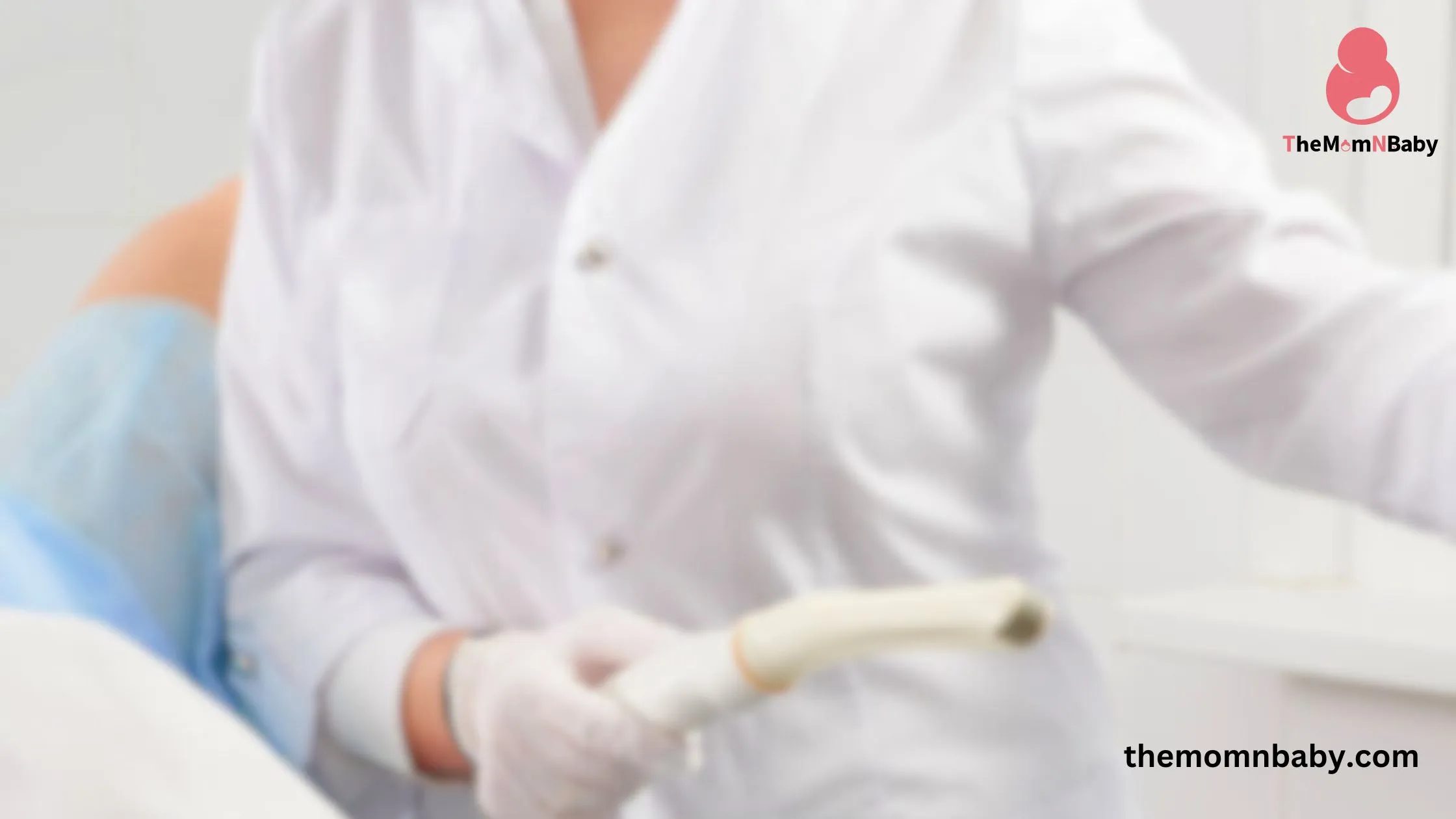
“Transvaginal Ultrasound or TVS during pregnancy” – Have You Ever Heard of This Term Before?
Transvaginal ultrasound (TVS)during pregnancy, which doctors sometimes call transvaginal sonography or TVS, is a very important test for pregnant women. It’s a safe and painless way for doctors to get a close look at the baby inside the mom’s belly. This test gives doctors lots of information about how the baby is growing and helps make sure both the mom and the baby are doing well. In this article, we’ll talk about what this test is for, how it’s done, why it’s safe, and why it’s so important for a healthy pregnancy.
Purpose of Transvaginal ultrasound (TVS) During Pregnancy
Transvaginal ultrasound (TVS)during pregnancy serves several important purposes:
- Confirming Pregnancy: Transvaginal ultrasound (TVS)helps doctors check if a woman is pregnant, especially in the early stages. It can also find out if there are more than one baby (like twins) and figure out how old the baby is in the womb.
- Assessing Fetal Development: This special ultrasound helps doctors see how the baby is growing. They can check if the baby’s body parts are developing correctly, like the heart, brain, and arms and legs.
- Identifying Potential Complications: Doctors use Transvaginal ultrasound (TVS)to look for any problems that might happen during pregnancy. They can find things like ectopic pregnancies (when the baby grows in the wrong place), molar pregnancies, or issues with the placenta, which is like the baby’s food supply.
- Guiding Procedures: Sometimes, doctors need to do other tests or procedures during pregnancy, like taking a tiny bit of fluid from around the baby (amniocentesis) or a piece of the placenta Chorionic villus sampling (CVS). Transvaginal ultrasound (TVS)helps them do these tests carefully by showing where they should put the needle or instrument. It’s like a GPS for doctors during these procedures.
The Transvaginal Ultrasound (TVS) Procedure
here’s a step-by-step explanation of the Transvaginal ultrasound (TVS)Procedure
- Getting Ready: First, you lie down on a comfortable table, like when you visit the doctor’s office.
- The Special Wand: The doctor or a technician gently puts a small, covered wand into your vagina. It’s like a long, thin stick, but it’s not painful.
- Sending Sound Waves: This wand sends safe sound waves into your belly. These waves bounce off the baby inside you.
- Creating Pictures: The sound waves bounce back, and a computer turns them into pictures on a screen. These pictures show the baby and other important things in your belly.
- Moving the Wand: The doctor or technician moves the wand a little to get different views of the baby and see everything clearly.
- Looking at the Pictures: The doctor looks at the pictures on the screen in real-time. They can see the baby’s heartbeat, how big the baby is, and if everything looks okay.
- No Pain: During the procedure, you might feel some pressure or discomfort, but it’s not painful. It’s quick and usually takes only a few minutes.
That’s how the Transvaginal ultrasound (TVS) Procedure works, helping doctors keep an eye on the baby and make sure everything is going well during pregnancy.
Safety of Transvaginal ultrasound (TVS)During Pregnancy
Transvaginal ultrasound (TVS)is considered safe during pregnancy when performed by trained healthcare professionals. Some important points to consider regarding its safety include:
- No Harmful Rays: Transvaginal ultrasound (TVS)is a safe way to take pictures of the baby in the mom’s belly because it doesn’t use any harmful rays like X-rays do. So, it doesn’t hurt the mom or the baby.
- Very Low Risks: The chances of something going wrong during Transvaginal ultrasound (TVS)are very, very small. One possible problem is getting an infection, but this is rare. It can happen if the equipment isn’t cleaned properly, but healthcare providers are usually very careful about this.
When Transvaginal ultrasound is done during pregnancy?
Early Pregnancy:
In the beginning, when a woman just finds out she’s pregnant around 6 weeks to 10 weeks, doctors often use transvaginal ultrasound. They do this to make sure everything is okay, like checking if there’s a baby growing and if the baby’s heart is beating. They also find out how far along the pregnancy is.
Early Second Trimester:
Sometimes, in the early part of the second trimester (around the fourth or fifth month 12 weeks to 16 weeks), doctors might use it again. This helps them take a closer look at the baby’s organs, like the brain and the heart.
Later Pregnancy:
Most of the time, doctors don’t use this type of ultrasound in the later months of pregnancy. By then, they can usually see everything they need with a regular ultrasound on the belly, which is more comfortable.
But, there are times when they might use it later, like if they’re worried about something specific with the baby’s position or the placenta. Also, if they need to do special tests, like taking a tiny bit of fluid around the baby, they might use Transvaginal ultrasound (TVS)to guide them and make sure it’s done safely. So, it really depends on what the doctor needs to check and when they need to do it..
Significance in Ensuring a Healthy Pregnancy
Transvaginal ultrasound (TVS)plays a pivotal role in ensuring a healthy pregnancy. Here are some key ways it contributes:
- Finding Problems Early: Transvaginal ultrasound (TVS)helps doctors spot any problems early in pregnancy. This is important because when issues are caught early, doctors can do something about them to keep both the mom and the baby safe.
- Watching How the Baby Grows: When you’re pregnant, you want to make sure the baby is growing the way it should be. Transvaginal ultrasounds let doctors keep an eye on the baby’s growth and make sure everything is on track.
- Getting Clear Answers: This type of ultrasound gives doctors really clear pictures. This helps them figure out what might be going on if there are any concerns. Having clear answers can make things less stressful for soon-to-be parents.
- Feeling Better: Seeing and hearing the baby’s heartbeat during a Transvaginal ultrasound (TVS)can be comforting for parents. It’s like a little reminder that the baby is doing well and growing strong.
So, Transvaginal ultrasound (TVS) is like a helpful tool to make sure everything is going smoothly during pregnancy, and it’s especially good at catching and addressing any potential issues early on.
What happens after a Transvaginal ultrasound (TVS)?
TVS results, which stand for “Transvaginal Ultrasound” results, provide crucial information about the health and development of the fetus during pregnancy. These results can vary widely depending on the purpose of the ultrasound and the stage of pregnancy. Here are some possible TVS results and what they may mean:
Normal Pregnancy:
If the Transvaginal ultrasound (TVS) shows that everything is going well with your pregnancy, you’ll probably just continue with your regular check-ups. Your doctor will keep an eye on how your baby is growing as your pregnancy goes on.
Concerns or Issues:
If the Transvaginal ultrasound (TVS) finds something that needs attention, your doctor will talk to you about it. You might need more tests or special appointments to make sure everything is okay. It really depends on what the TVS showed.
High-Risk Pregnancy:
Some pregnancies are considered high-risk because of certain medical conditions or past problems. If you have a high-risk pregnancy, your doctor will give you extra care and might do more tests to keep a close watch on you and your baby.
Guiding Procedures:
Sometimes, the Transvaginal ultrasound (TVS) is used to help with a specific procedure, like taking a tiny bit of fluid or tissue around the baby. After the procedure, your doctor will explain what’s next and what to expect.
More Ultrasound Scans:
As you move through your pregnancy, you’ll probably have more ultrasound scans. These help your doctor make sure your baby is growing and developing properly.
Keep Talking:
No matter what the TVS shows, it’s really important to keep talking with your doctor. If you have questions, concerns, or notice any changes in how you’re feeling during your pregnancy, don’t hesitate to share them with your healthcare team. They’re there to help you have a healthy pregnancy.
Transvaginal ultrasound (TVS) during pregnancy is like a very helpful tool. It helps doctors find problems early, check how the baby is growing, and make sure both the mom and baby are healthy. It’s safe and really important in taking care of pregnant moms and their babies.
Doctors and parents-to-be get important information from it to make good decisions during pregnancy. But remember, it’s different for each pregnancy, so talk to your doctor about when and how many times you might need these ultrasounds. They’ll figure out what’s best for you and your baby.
Find More : Pregnancy Growth Week By Week Development
People Also Ask About Transvaginal ultrasound (TVS) During Pregnancy:
1. What is a transvaginal ultrasound (TVS) and how is it different from a regular ultrasound?
– TVS is a medical procedure that uses a special ultrasound wand inserted into the vagina to create detailed images of the reproductive organs and developing fetus during pregnancy. It differs from a regular ultrasound, which is done externally on the abdomen.
2. Is Transvaginal Ultrasound (TVS) safe during pregnancy, and why is it used?
– TVS is generally considered safe when performed by trained healthcare professionals. It is used during pregnancy to confirm pregnancy, assess fetal development, detect potential complications, and guide certain procedures. Its safety lies in the fact that it uses sound waves, not harmful radiation.
3. When is Transvaginal Ultrasound (TVS) typically performed during pregnancy?
– TVS is often done in the early stages of pregnancy, primarily during the first trimester, to confirm pregnancy, determine gestational age, and assess fetal development. It may also be used in the early part of the second trimester for specific purposes.
4. What can Transvaginal Ultrasound (TVS) reveal about the pregnancy and the fetus?
– TVS can provide information about the number of fetuses, gestational age, fetal development, placental health, and potential abnormalities. It offers detailed insights into the well-being of both the mother and the baby during pregnancy.
5. Are there any risks or discomfort associated with TVS?
– TVS carries minimal risks, such as a small chance of infection if proper sterilization procedures are not followed. Discomfort during the procedure is generally mild and often described as pressure rather than pain.





